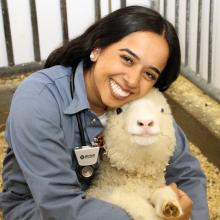On this week’s blog post, I want to cover a topic that perhaps isn’t talked about as much as it should be: the business aspect of a veterinary clinic. I’m guilty of getting so wrapped up in the medicine component of a clinic that I forget being a veterinarian, in particular a practice owner, involves a great deal of business management. Running a clinic entails practicing good veterinary medicine but also, thinking about revenue, training and managing staff, keeping controlled substance logs, maintaining satisfied clients, having a good public perception and a lot of other components that often go unnoticed.
I often am told that vets charge too much for their services and that all vets must be wealthy based on the cost of a single vet visit. I’m here to bust that myth – veterinarians have a much smaller profit margin than you would expect. Of course, that’s not true for all clinics but it’s certainly true for Gray County Veterinary Clinic. A day at GCVC includes the following expenses: electricity, property taxes, the building loan, payroll, inventory, hospital supplies and cleaning supplies. As you can easily identify, it’s expensive to own a practice and the services provided don’t always leave large enough margins to be very profitable.
From ensuring short wait times to providing the appropriate treatment, the clinic works diligently to provide a positive experience for the patient and the owner. But similar to a restaurant, there is plenty of prep work and meal preparation that is required for an order to be completed and then served to you at your table.
In terms of a veterinary clinic, “behind the scenes” includes areas such as the pharmacy and the treatment room as well as the management and effort required for the clinic to run efficiently. Ample time is spent optimizing schedules, discussing ways to improve client education, identifying gaps in provided services, keeping up to date on current medicine/drugs, logging controlled substances and plenty more. Although every clinic varies in their operation, the activities listed are more or less consistent with all veterinary clinics. With all of that being said, I am empathetic about the public perception of veterinarians. From a client’s point of view, the perceived value of an appointment is what meets the eye. A client sees and experiences the “front” part of the clinic, which includes the reception area, waiting room and the medical examination room. The “behind the scenes” are exactly that, they are the components of the clinic that the client more often than not, does not get to see. However, I hope that at this point in the blog post, you’re realizing that the commitment needed to run a veterinary clinic is a lot more involved than meets the eye.
From ensuring there is enough revenue coming in, to satisfying clients for the cost of services, being a veterinarian is stressful, hectic and demanding. But do you want to know why this career is so rewarding? Aside from getting to help animals, it’s incredibly gratifying when you put a big smile on an owner’s face after you’ve helped and provided relief to their sick pet.
Countless clients at GCVC have brought in cupcakes, treats, cards and flowers to show their gratitude to the staff. It’s not what they bring to the clinic but more so, the gesture and appreciation they give – it makes the staff feel acknowledged for their effort. I’m so thankful for all the wonderful clients I’ve met during my externship. Many have gone out of their way to remember my name and get to know a little bit more about me, the kindness shown to me has been the best possible introduction to working at a veterinary clinic.
